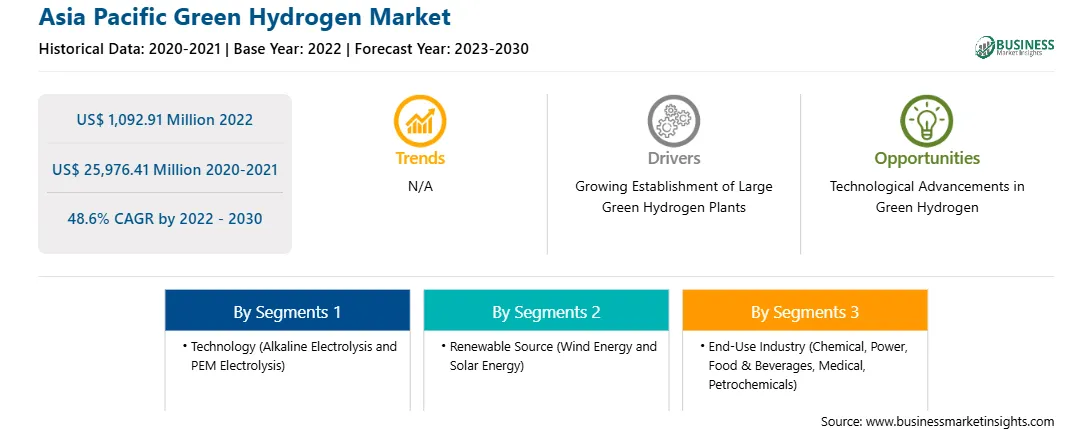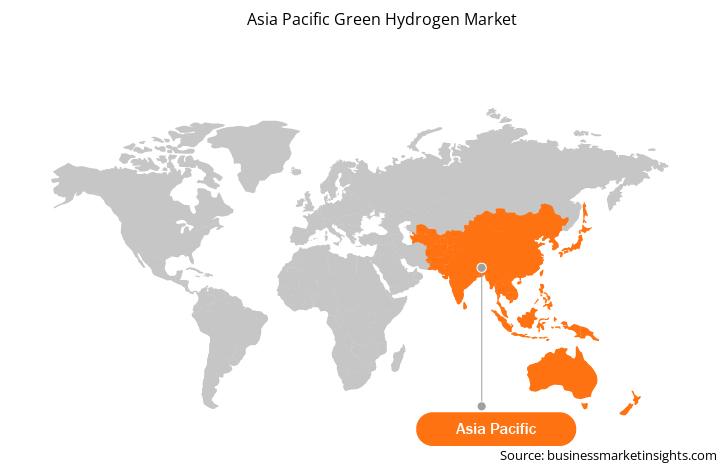The establishment of large-scale green hydrogen plants attracts significant investments from both the public and private sectors. In June 2023, a group of companies announced their plan to invest US$ 79.75 in a project for the development of a hydrogen production facility and a hydrogen liquefaction facility in Queensland, Australia. The group of companies includes Iwatani Corporation (Japan), Kansai Electric Power Company (Japan), Marubeni Corporation (Japan), Keppel Infrastructure (Singapore), and Stanwell Corporation (Australia).
Large-sized green hydrogen plants require dedicated infrastructure, including hydrogen production facilities, storage systems, and transportation networks. The establishment of such plants drives the requirement for a robust infrastructure that supports the distribution and utilization of green hydrogen. For instance, in June 2023, Larsen & Toubro announced its plan to set up infrastructure for the world’s largest green hydrogen plant in Saudi Arabia, which is being built by NEOM Green Hydrogen Company (NGHC). Thus, a rise in infrastructure development is expected to create a favorable environment for the adoption of green hydrogen in different sectors, which is likely to offer growth opportunities to the market players during the forecast period.
Asia Pacific is witnessing intense competition among companies aiming to establish green hydrogen production bases, recognizing its potential as a next-generation power source. Leading the charge are Western and regional companies teaming up for massive projects. Danish multinational Orsted, a major offshore wind power company, is exploring entry into the green hydrogen market. The company partnered with South Korean steelmaker POSCO for an offshore wind power project in May 2021. It is studying the feasibility of green hydrogen production. Western oil companies are also making significant investments in the region. For instance, in June 2022, BP became the largest shareholder in the Asian Renewable Energy Hub (AREH) project in Australia, aiming to produce up to 1.6 metric ton of green hydrogen annually and secure a 10% share of the global market.
The Asia Pacific green hydrogen market is segmented into technology, renewable source, end-use industry, and country.
Based on technology, the Asia Pacific green hydrogen market is bifurcated into alkaline electrolysis and PEM electrolysis. The alkaline electrolysis segment accounted a larger share of the Asia Pacific green hydrogen market in 2022.
By renewable source, the Asia Pacific green hydrogen market is divided into wind energy and solar energy. The solar energy segment held a larger share of the Asia Pacific green hydrogen market in 2022.
By end use, the Asia Pacific green hydrogen market is segmented into chemical, power, food & beverages, medical, petrochemicals, and others. In 2022, the power segment held a largest share of the Asia Pacific green hydrogen market.
Based on country, the Asia Pacific green hydrogen market is segmented into Australia, China, India, Japan, South Korea, and the Rest of Asia Pacific. China dominated the Asia Pacific green hydrogen market in 2022.
Air Products & Chemicals Inc, Cummins Inc, Engie SA, L’Air Liquide SA, Linde Plc, Nel ASA, Siemens Energy AG, and Toshiba Energy Systems & Solutions Corp are some of the leading companies operating in the Asia Pacific green hydrogen market.
Strategic insights for the Asia Pacific Green Hydrogen provides data-driven analysis of the industry landscape, including current trends, key players, and regional nuances. These insights offer actionable recommendations, enabling readers to differentiate themselves from competitors by identifying untapped segments or developing unique value propositions. Leveraging data analytics, these insights help industry players anticipate the market shifts, whether investors, manufacturers, or other stakeholders. A future-oriented perspective is essential, helping stakeholders anticipate market shifts and position themselves for long-term success in this dynamic region. Ultimately, effective strategic insights empower readers to make informed decisions that drive profitability and achieve their business objectives within the market.

| Report Attribute | Details |
|---|---|
| Market size in 2022 | US$ 1,092.91 Million |
| Market Size by 2030 | US$ 25,976.41 Million |
| Global CAGR (2022 - 2030) | 48.6% |
| Historical Data | 2020-2021 |
| Forecast period | 2023-2030 |
| Segments Covered |
By Technology
|
| Regions and Countries Covered | Asia-Pacific
|
| Market leaders and key company profiles |
The geographic scope of the Asia Pacific Green Hydrogen refers to the specific areas in which a business operates and competes. Understanding local distinctions, such as diverse consumer preferences (e.g., demand for specific plug types or battery backup durations), varying economic conditions, and regulatory environments, is crucial for tailoring strategies to specific markets. Businesses can expand their reach by identifying underserved areas or adapting their offerings to meet local demands. A clear market focus allows for more effective resource allocation, targeted marketing campaigns, and better positioning against local competitors, ultimately driving growth in those targeted areas.

The Asia Pacific Green Hydrogen Market is valued at US$ 1,092.91 Million in 2022, it is projected to reach US$ 25,976.41 Million by 2030.
As per our report Asia Pacific Green Hydrogen Market, the market size is valued at US$ 1,092.91 Million in 2022, projecting it to reach US$ 25,976.41 Million by 2030. This translates to a CAGR of approximately 48.6% during the forecast period.
The Asia Pacific Green Hydrogen Market report typically cover these key segments-
The historic period, base year, and forecast period can vary slightly depending on the specific market research report. However, for the Asia Pacific Green Hydrogen Market report:
The Asia Pacific Green Hydrogen Market is populated by several key players, each contributing to its growth and innovation. Some of the major players include:
The Asia Pacific Green Hydrogen Market report is valuable for diverse stakeholders, including:
Essentially, anyone involved in or considering involvement in the Asia Pacific Green Hydrogen Market value chain can benefit from the information contained in a comprehensive market report.